Physical Address
304 North Cardinal St.
Dorchester Center, MA 02124
Transesophageal echocardiography (TEE) has proven utility in a number of clinical scenarios, including the operating room, intensive care unit, and outpatient setting. The rapid growth of structural heart disease interventions has led to a greater appreciation of the role of TEE in both disease diagnosis as well as procedural guidance. Thus, TEE has become an essential interdisciplinary imaging tool for cardiac surgeons, anesthesiologists, cardiac interventionalists, and clinical cardiologists. The “Guidelines for Performing a Comprehensive Transesophageal Echocardiography Examination: Recommendations from the American Society of Echocardiography and the Society of Cardiovascular Anesthesiologists” reviews all aspects of TEE training and image acquisition, provides a current definition of a “Comprehensive TEE Examination” and names a set of 28 TEE views (see Figures 13.1–13.4 ), utilizing four levels of imaging (see Figure 13.5 ) intended to facilitate and provide consistency in training, reporting, archiving, and quality assurance in the multiplane TEE examination. Eight additional views have been added to the prior “ASE/SCA Guidelines for Performing a Comprehensive Intraoperative Multiplane Transesophageal Echocardiography Examination” and include:
Midesophageal (ME) five-chamber view
ME modified bicaval tricuspid valve (TV) view
Upper esophageal (UE) right and left pulmonary veins view
ME left atrial appendage (LAA) view
Transgastric (TG) apical short-axis (SAX) view
TG long-axis (LAX) view
TG right ventricular basal view
TG right ventricular inflow–outflow view
With these additional views, complete imaging of right and left heart structures can be performed for either a diagnostic or intraprocedural TEE.
The new guidelines present a suggested imaging protocol to facilitate a description of probe manipulation for image acquisition. However, the number and order of image acquisition may vary based on the indication for study and the patient’s clinical status. In addition, the comprehensive imaging views in the protocol are not intended to represent all the imaging planes that can be obtained when imaging specific structures. The following is a summary of the 28 recommended views with discussion of additional views that may be obtained by small adjustments in position of the probe or transducer angle, which may allow a more comprehensive evaluation of specific structures ( ![]() , , , , , , , , , , , , , , , , , , , , , , , , , , , ). A discussion of the specific indications for TEE (i.e., endocarditis or cardiac source of embolus) is beyond the scope of this chapter.
, , , , , , , , , , , , , , , , , , , , , , , , , , , ). A discussion of the specific indications for TEE (i.e., endocarditis or cardiac source of embolus) is beyond the scope of this chapter.
Video 13.1. Midesophageal five-chamber view.
Video 13.2. Midesophageal four-chamber view.
Video 13.3. Midesophageal mitral commissural view.
Video 13.4. Midesophageal two-chamber view.
Video 13.5. Midesophageal long-axis view.
Video 13.6. Midesophageal aortic valve long-axis view.
Video 13.7. Midesophageal ascending aorta long-axis view.
Video 13.8. Midesophageal ascending aorta short-axis view.
Video 13.9. Midesophageal right pulmonary vein view.
Video 13.10. Midesophageal aortic valve short-axis view.
Video 13.11. Midesophageal right ventricular inflow–outflow view.
Video 13.12. Midesophageal modified bicaval tricuspid valve view.
Video 13.13. Midesophageal bicaval view.
Video 13.14. Upper esophageal right and left pulmonary veins view.
Video 13.15. Midesophageal left atrial appendage view.
Video 13.16. Transgastric basal short-axis view.
Video 13.17. Transgastric midpapillary short-axis view.
Video 13.18. Transgastric apical short-axis view.
Video 13.19. Transgastric right ventricular basal view.
Video 13.20. Transgastric right ventricular inflow–outflow view.
Video 13.21. Deep transgastric five-chamber view.
Video 13.22. Transgastric two-chamber view.
Video 13.23. Transgastric right ventricular inflow view.
Video 13.24. Transgastric long-axis view.
Video 13.25. Descending aorta short-axis view.
Video 13.26. Descending aorta long-axis view.
Video 13.27. Upper esophageal aortic arch long-axis view.
Video 13.28. Upper esophageal aortic arch short-axis view.
Three-dimensional (3D) imaging includes both the use of simultaneous biplane imaging and acquisition of 3D volumes and may be acquired at any point in the routine protocol but should be guided by the intended structure to be imaged. Because of the way the 3D volume is generated (typically sweeping from front to back of the acquired volume) and depending on the acquisition protocol (i.e., single-beat vs multibeat acquisitions or narrow sector vs user-defined sector) resolution of structures imaged may be determined by primary imaging planes. Some of these considerations are discussed within the individual imaging views and covered more extensively in other chapters.
The comprehensive transesophageal echocardiographic (TEE) examinations should include the 28 views outlined with addition of a Doppler examination for functional assessment when appropriate ( Figs. 13.1 to 13.4 ). The performance of a comprehensive or complete TEE examination should be performed whenever possible.
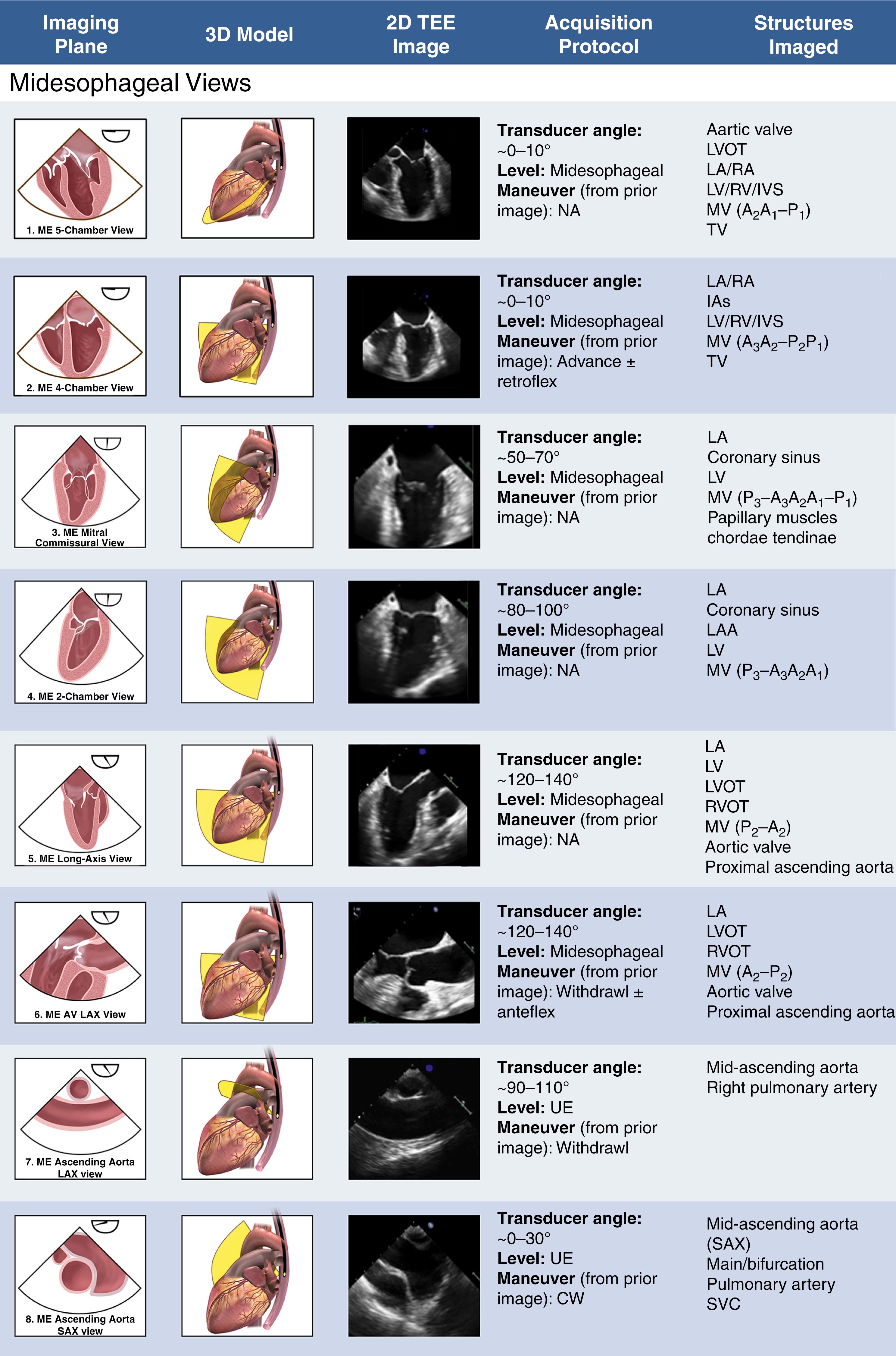
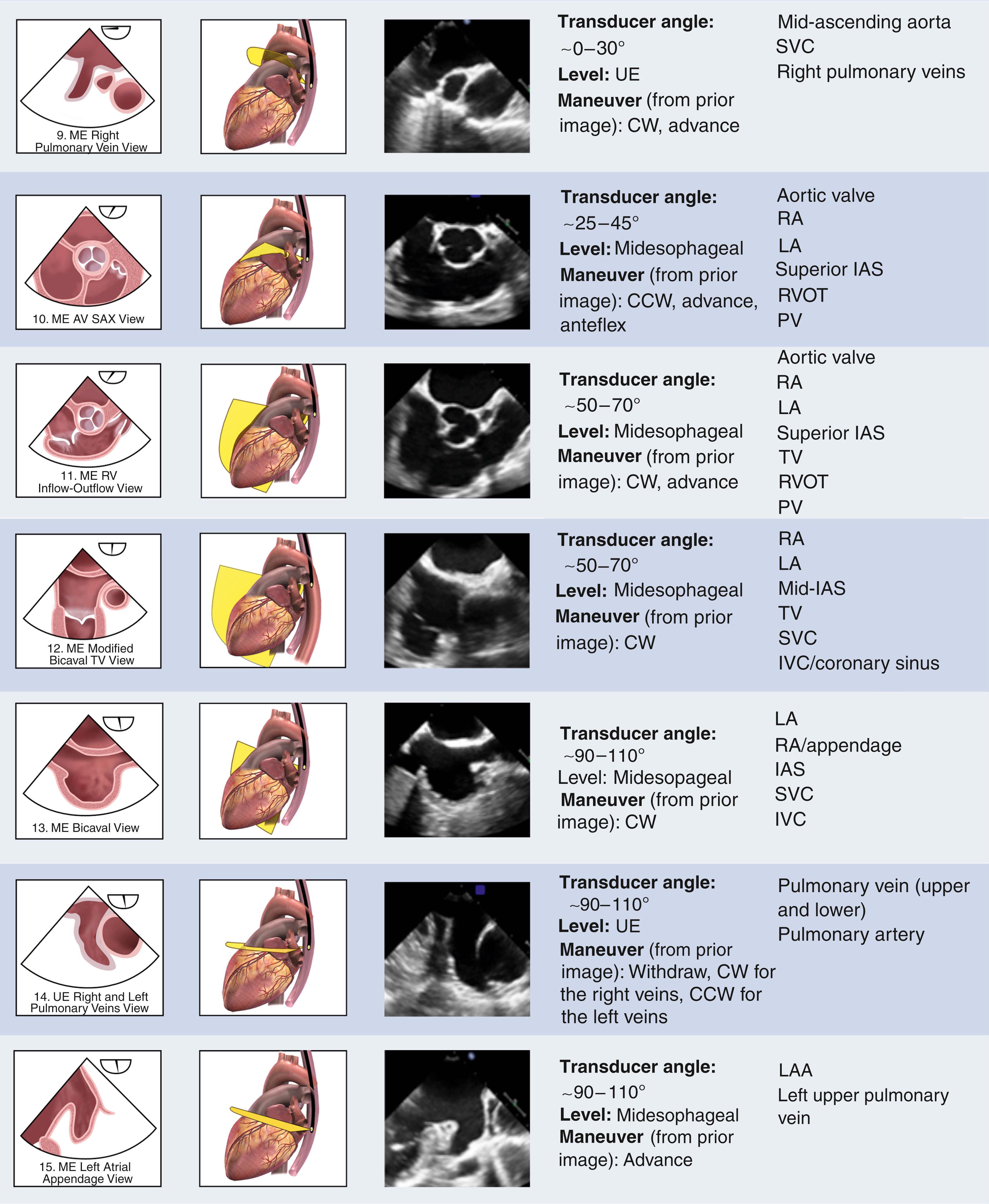
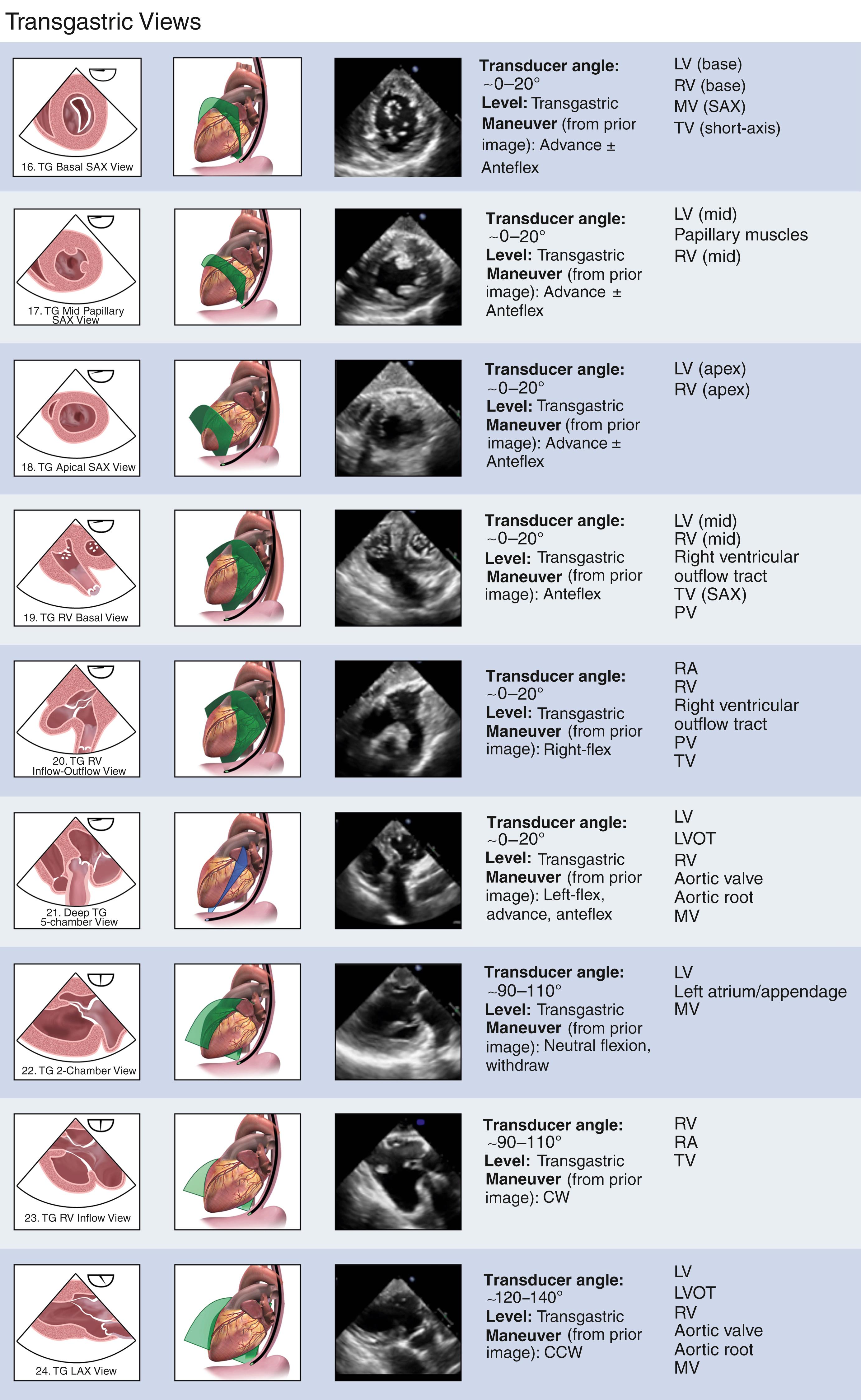
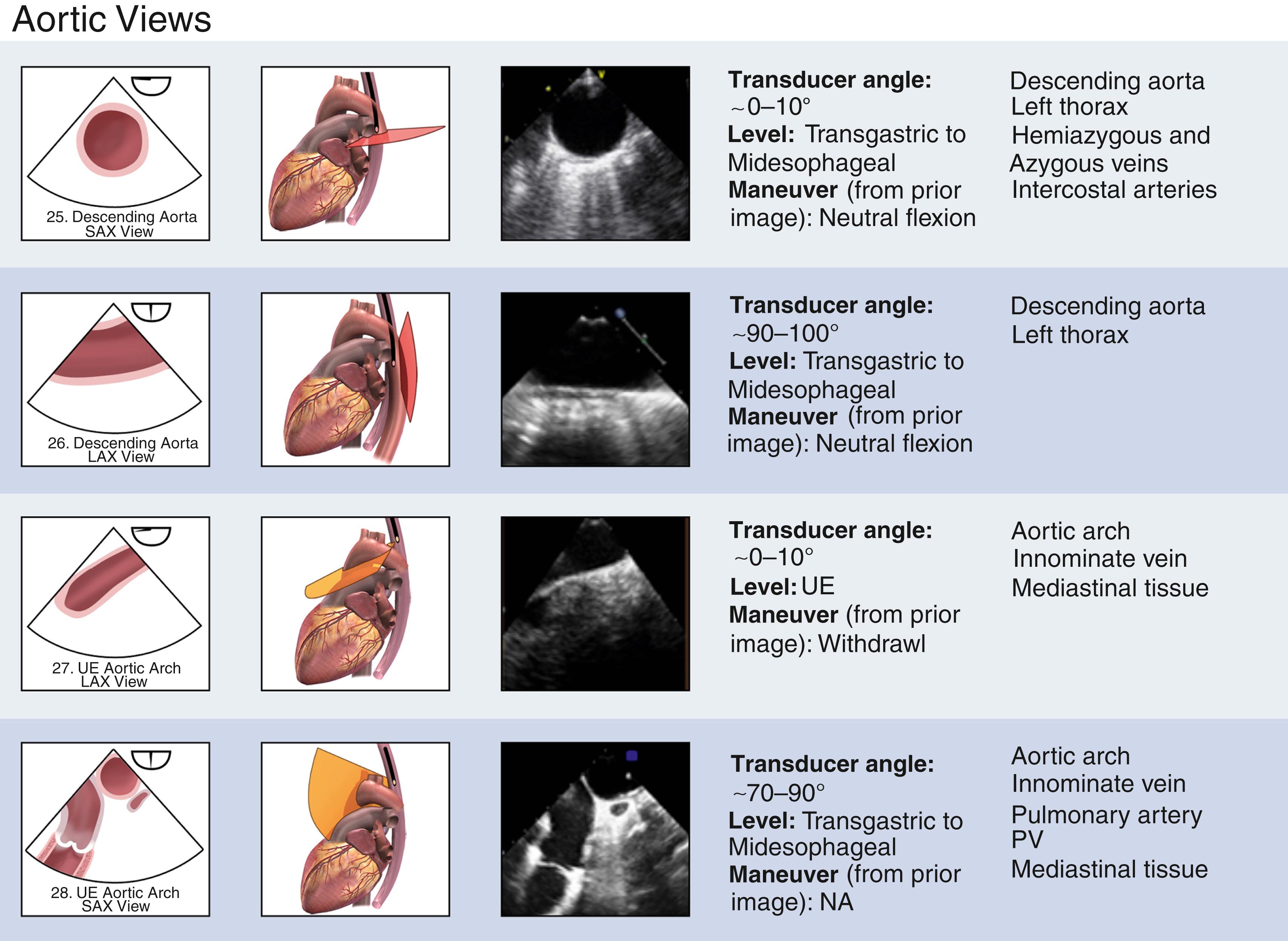
Use of all five manipulations of the TEE probe is typically required during image acquisition ( Fig. 13.5 ): advancing or withdrawing the transducer, manual rotation (clockwise [toward the right] and counterclockwise [toward the left] rotation), right and left lateral flexion, anterior and posterior flexion, and mechanical rotation.
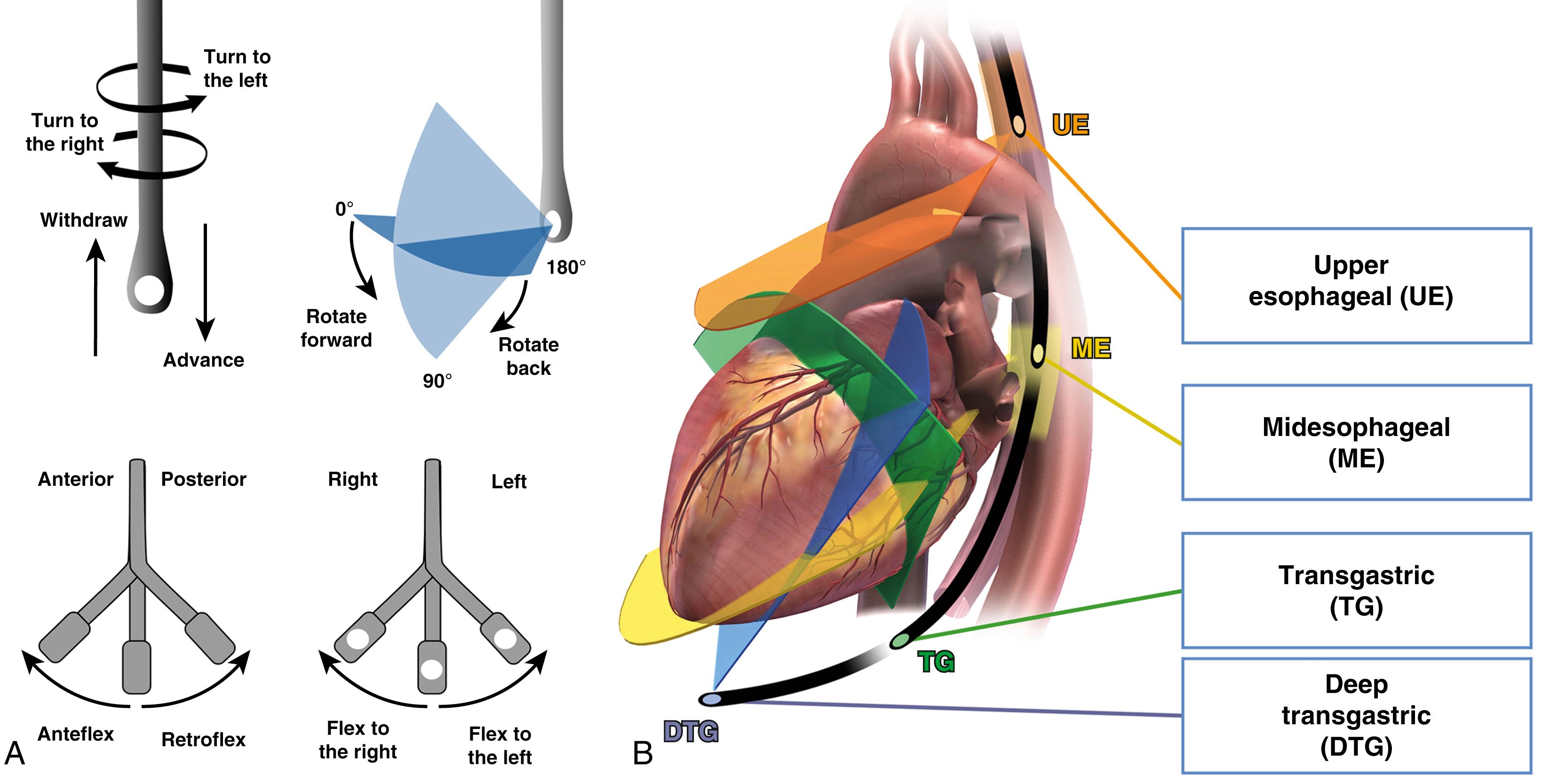
To avoid injury to the esophagus, a neutral probe position is used to rotate or advance or withdraw the probe before adjusting flexion.
Three-dimensional imaging (which includes simultaneous multiplane imaging) is an essential tool to describe the morphology of complex structures.
After initially passing the probe into the esophagus, it is slowly advanced until the aortic valve (AV) and left ventricular (LV) outflow tract (LVOT) come into view at a probe depth of about 30 cm. Slight transducer angle manipulation (10-degree rotation) allows image optimization of the AV and LVOT. In this plane, the LA, right atrium (RA), LV, right ventricle (RV), mitral valve (MV), and TV are also imaged, hence the name “ME five-chamber view” (see Fig. 13.1 ). This view allows visualization of the A 2 A 1 and P 1 P 2 scallops (from left to right on the imaging plane) of the MV and two of the three AV cusps. Color-flow Doppler can be applied to aid in identifying aortic, mitral, and tricuspid regurgitation. In the neutral probe position, the true apex of the ventricles may not be imaged; simultaneous multiplane imaging can confirm that the apex is not centered in the orthogonal plane. To image the apex and acquire the longest axis of the LV, retroflexion is typically required.
The midesophageal five-chamber view is usually the initial image obtained when inserting the probe in the neutral position.
Retroflexion of the probe is typically required to image the apex of the heart.
From the ME five-chamber view, if the apex of the LV has been imaged using retroflexion, then mechanical rotation of approximately 10 to 20 degrees to eliminate the AV or LVOT from the image display results in the ME four-chamber view (see Fig. 13.1 ). If the AV is still imaged, the probe may need to be advanced. The image depth is then adjusted to ensure viewing of the LV apex. Note that this view is typically deeper than the ME five-chamber view, and the AV and LV outflow tract will not be visualized. Furthermore, the transducer angle may need to be rotated to maximize the tricuspid annular dimension. To better align the MV and LV apex, slight probe retroflexion may be necessary. With an appropriately aligned four-chamber view, a single-plane measurement of the mitral annulus can be made for the assessment of diastolic transmitral stroke volume; a pulsed Doppler sample volume should be placed at the annulus to acquire a spectral Doppler profile for velocity time integral measurement. Diastolic function assessment by TEE has been validated using the lateral mitral annular e′ velocity (abnormal <10 cm/s) and transmitral E to e° ratio (normal ≤8) as indicative of diastolic dysfunction. Structures seen include the LA, RA, interatrial septum, LV, RV, interventricular septum, MV (A 3 A 2 and P 2 P 1 scallops), and TV. The TV septal leaflet adjacent to the interventricular septum is to the right of the sector display, and the TV posterior leaflet is adjacent to the RV free wall, to the left of the display.
The ME four-chamber view is one of the most comprehensive views available for evaluating cardiac anatomy and function. Turning the probe to the left (counterclockwise) allows imaging of primarily left heart structures. Turning the probe to the right (clockwise) allows imaging of primarily right heart structures. Diagnostic information obtained from this view include MV and TV function, assessment of global LV and RV systolic function and of regional left (inferoseptal and anterolateral), and right (lateral) wall function. Color-flow Doppler can be applied to aid in identifying aortic, mitral, and tricuspid regurgitation. After slight probe advancement, the coronary sinus is imaged in the long axis immediately above the attachment of the TV septal leaflet to the interventricular septum.
Simultaneous multiplane imaging is unique to the matrix array transducer and permits the use of a dual screen to simultaneously display two real-time two-dimensional (2D) images ( Fig. 13.6 ). The primary image is the reference view, and the second view can be generated with typically two modifiable manipulations. First, the angle of the secondary view in reference to the primary view can be modified (typical default angle of 90 degrees). Second, the lateral location of the secondary view in reference to the primary view but can be manipulated (typical default position in the midline of the sector). The 90-degree orthogonal image is oriented as if forward rotated from the primary view. Thus, when the primary imaging plane reaches 90 degrees, the orthogonal multiplane image may appear “reversed” compared with standard single-plane imaging. The orthogonal view obtained during simultaneous biplane imaging of the ME four-chamber view is the ME two-chamber view (see Fig. 13.2 ). 3D full-volume acquisitions of the ventricle can be performed for assessment of ejection fraction.
The midesophageal four-chamber view is one of the most comprehensive views available for evaluating cardiac anatomy and function. Measurement of the mitral annulus from this (or the two-chamber view) can be used to quantify diastolic stroke volume.
To obtain the four-chamber view, the transducer angle may need to be rotated to approximately 10 to 20 degrees to eliminate the aortic valve or left ventricular (LV) outflow tract from the image display and to maximize the tricuspid annular dimension, with slight probe retroflexion to image the true LV apex.
From the ME four-chamber view, rotating the transducer angle to between 50 and 70 degrees generates the ME mitral commissural view (see Fig. 13.1 ). The MV scallops on the image display (from left to right) are P 3 , A 2 , and P 1 , although frequently, adjacent A 3 and A 1 segments can also be imaged (P 3 –A 3 A 2 A 1 –P 1 ). From this neutral probe orientation, rotating the probe leftward (counterclockwise) may allow imaging of the length of the posterior leaflet (P 3 P 2 P 1 ), and continued counterclockwise rotation will image the posterior mitral annulus, coronary sinus, or circumflex artery. Turning the probe rightward (clockwise from the neutral position) may allow imaging of the length of the anterior leaflet (A 3 A 2 A 1 ). In addition, the anterolateral and posteromedial papillary muscles with their corresponding chordae are prominent structures in the ME commissural view. Diagnostic information obtained from this view includes global and regional LV function (anterior/anterolateral and inferior/inferolateral walls) and MV function. Color-flow Doppler can be applied to aid in identifying commissural mitral regurgitation jets.
The orthogonal view obtained during simultaneous biplane imaging is the ME LAX view (see Fig. 13.6 ). Sweeping across the commissural plane with simultaneous biplane imaging allows for evaluation of the entire line of mitral leaflet coaptation: medial P 1 /A 1 , mid P 2 /A 2 , and lateral P 3 /A 3 . 3D narrow sector acquisition (with or without color) to assess the MV orifice can be performed from this view; the entire mitral coaptation length is imaged in the lateral plane with the coaptation of the two leaflets in the elevational plane.
The midesophageal mitral commissural view images the medial (to the left of the screen) and lateral (to the right of the screen) commissures of the mitral valve and usually the largest annular dimension.
Using simultaneous multiplane imaging (i.e., biplane imaging) to scan through the commissures, the orthogonal view allows for evaluation of the entire line of mitral leaflet coaptation: medial P 1 /A 1 , mid P 2 /A 2 , and lateral P 3 /A 3 .
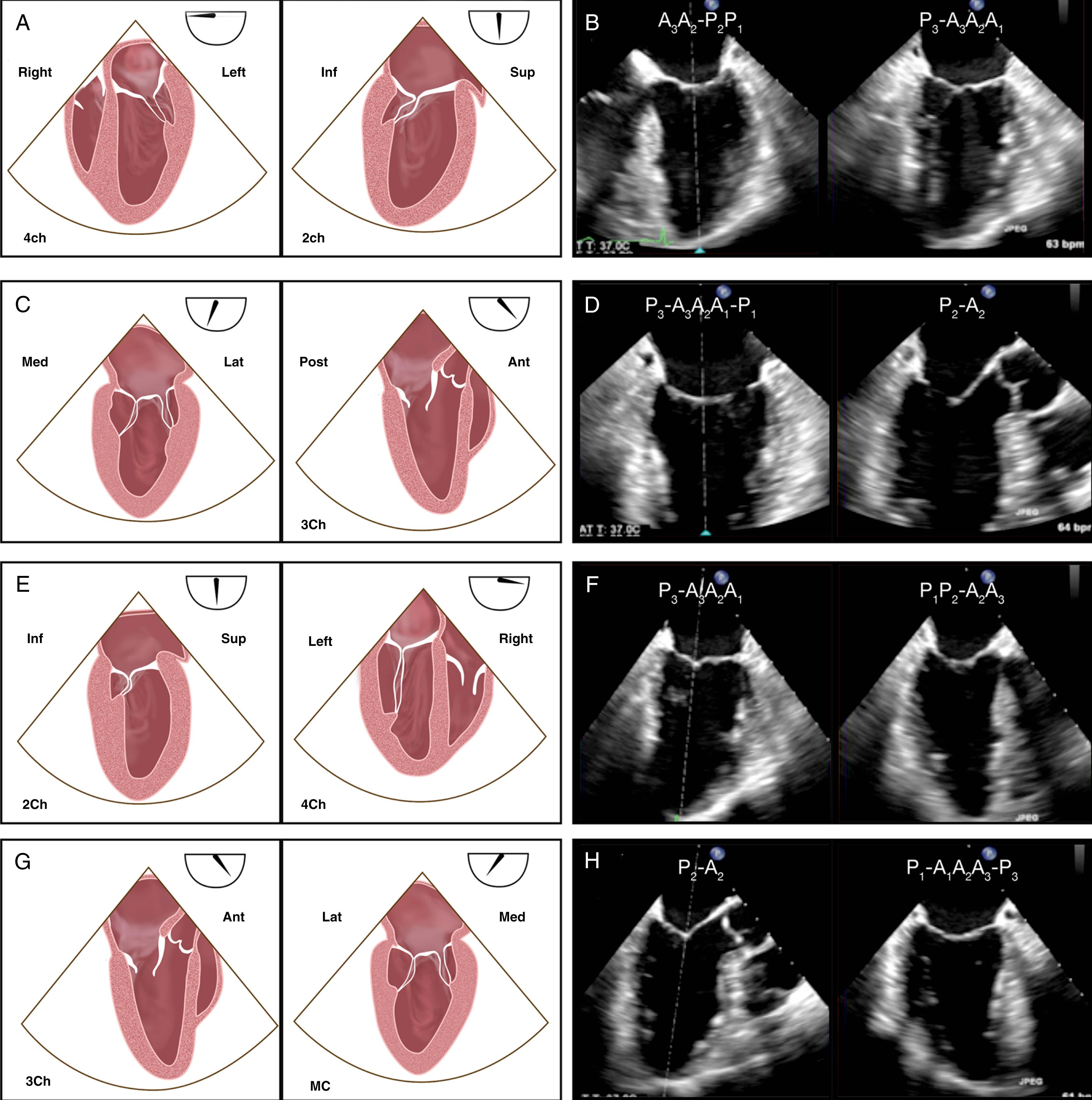
From the ME mitral commissural view, rotating the transducer angle to between 80 and 100 degrees generates the ME two-chamber view (see Fig. 13.1 ). Structures seen include the LA, LA appendage, LV, and MV (P 3 -A 3 A 2 A 1 ). Diagnostic information obtained from this view includes global and regional LV function (anterior and inferior walls) and MV function. Color-flow Doppler applied over the MV to aid in identification of valvular pathology (regurgitation, stenosis, or both). The coronary sinus is seen in short axis immediately above the basal inferior LV segment. The orthogonal view obtained during simultaneous biplane imaging is the ME four-chamber view (see Fig. 13.6 ); however, the left heart is now to the left of the display (mirror image of 0-degree view). Rotating to the right (clockwise) at this transducer angle results in the ME bicaval view (see view #13, Fig. 13.2 ). Rotating to the left (counterclockwise) at this transducer angle results in the ME LAA view (see view #15, Fig. 13.2 ).
The simultaneous multiplane image default is 90 degrees forward rotated from the primary image ( Fig. 13.6 ). Thus, the orthogonal view obtained using the midesophageal two-chamber view would be 180 degrees forward rotated, resulting in an left-right inverted four-chamber view: the left heart is now to the left of the display (mirror image of 0-degree view).
From the ME two-chamber view, the transducer angle is rotated to approximately 120 to 140 degrees to image the ME LAX view, which is the same as the transthoracic three-chamber view. Structures seen include the LA, LV, LVOT, AV, proximal ascending aorta, coronary sinus, and MV (P 2 –A 2 ). Diagnostic information obtained from this view includes global and regional LV function (inferolateral and anterior septal walls), MV, and AV function. The membranous interventricular septum as well as the RV wall that subtends the RV outflow tract (RVOT) can also be imaged. The orthogonal view obtained during simultaneous biplane imaging is the ME mitral commissural view (see Fig. 13.6 ); however, the anterior/anterolateral LV wall is now to the left of the display (mirror image of 60-degree view). Color-flow Doppler can be applied to identify aortic regurgitation.
The midesophageal long-axis view is a key view to image the relationship between the mitral valve, the aortic valve, and the left ventricular outflow tract and ascending aorta. The mitral-aortic angle can be measured from this view.
Measurements of mitral leaflet lengths to inform surgical or transcatheter devices may be performed from this view.
From the ME LAX view, anteflexion of the probe while maintaining a transducer angle of 120 to 140 degrees results in the ME AV LAX view (see Fig. 13.1 ). Optimizing the image to bisect the largest aortic root diameter can be accomplished with slight insertion and right or left rotation. Reducing the depth of field allows concentrated imaging of the LVOT, AV, and proximal aorta, including the sinus of Valsalva and sinotubular junction. This view is useful in evaluating the AV function and obtaining the dimensions of the annulus and sinotubular junction. The anterior (far-field) AV cusp is the right coronary cusp; frequently, the right coronary ostium is imaged from this view. The posterior (near-field) cusp can be the noncoronary cusp or the left coronary cusp, depending on the window; when perfectly centered on the aorta, however, the plane of imaging may be at the commissure between these two cusps. The orthogonal view obtained during simultaneous biplane imaging is a SAX view of the AV (see Fig. 13.7 ); however, the right heart is now to the right of the display (mirror image of the single 2D AV SAX imaging view #10). Color-flow Doppler can be applied to identifying aortic regurgitation as well as flow within the right coronary ostium.
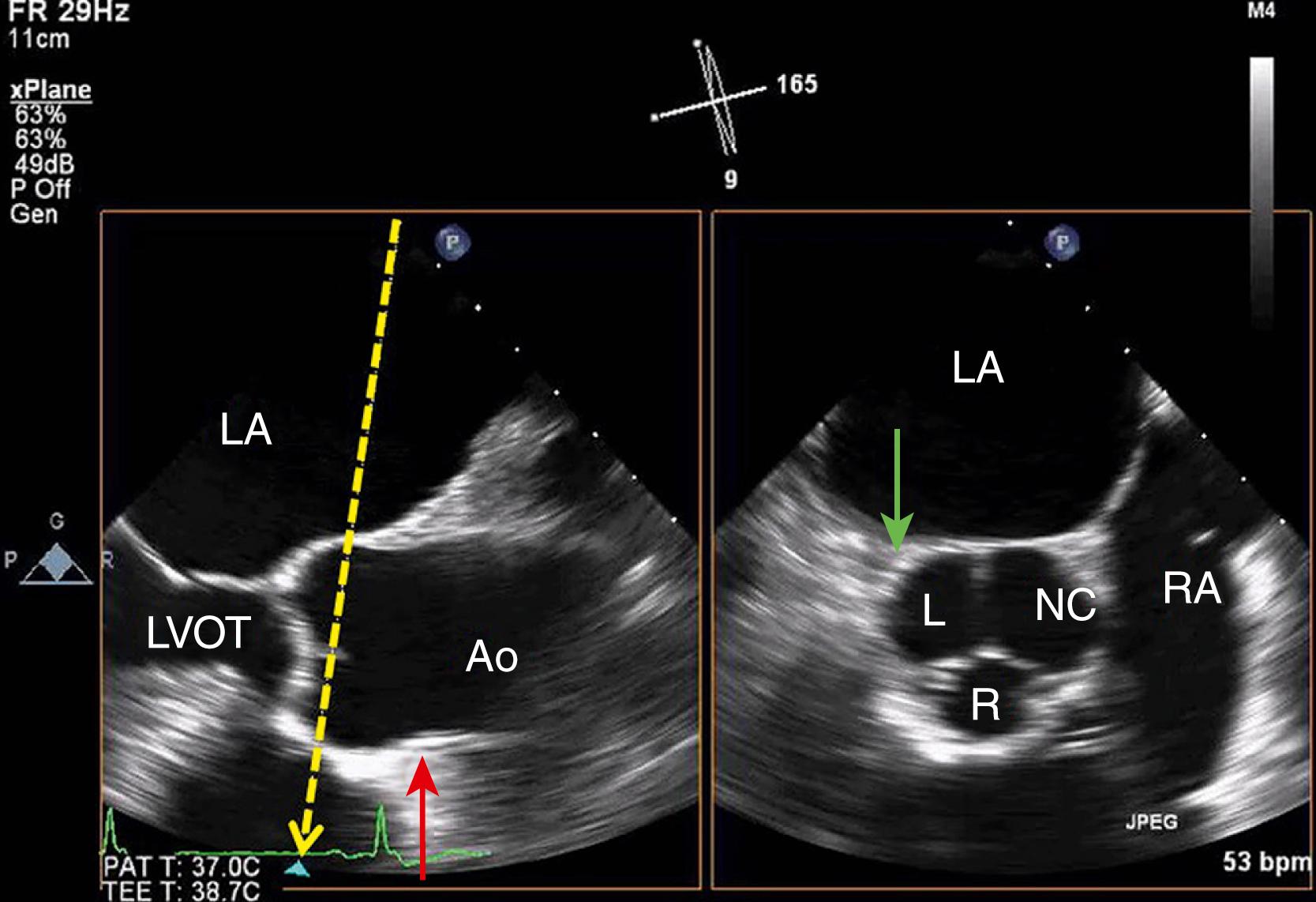
The ME AV LAX view is one of the main views used for transcatheter AV procedures. , The sagittal plane measurement of the annulus and LVOT is performed from this view. The use of simultaneous biplane imaging may assist acquisition of the largest annular diameter. A user-defined (zoomed) 3D volume of the AV can be obtained from this view (or the AV SAX view) to measure annular area and perimeter, , as well as the location of the coronary ostia. Color Doppler 3D acquisition can be useful for assessing the severity of aortic regurgitation.
The midesophageal (ME) aortic valve (AV) long-axis view is useful in evaluating AV function and obtaining the dimensions of the annulus and sinotubular junction.
The simultaneous multiplane orthogonal view is the ME AV short-axis view (see later); however, the left heart is now to the left of the display (mirror image of 0-degree view).
From the ME AV LAX view, withdrawal of the probe, typically with backward rotation to approximately 90 degrees, results in the ME ascending aorta LAX view (see Fig. 13.1 ). This view allows for evaluation of the proximal ascending aorta. The right pulmonary artery (PA) lies posterior to the ascending aorta in this view. Although aortic flow is typically perpendicular to the insonation beam from this view, color-flow Doppler may still be useful in some pathologies. By centering the image plane on the SAX image of the right PA (in the near field), turning the probe to the left (counterclockwise) with possible retroflexion results in LAX imaging of the main PA and the PV. This view aligns the insonation beam with PA flow and optimizes the imaging plane for pulsed-wave (PW), continuous-wave (CW), and color Doppler of the RVOT, PV, or main PA. The orthogonal view obtained during simultaneous biplane imaging is mirror image of the ME ascending aortic SAX view (view #8) with the PA to the left of the aorta.
From the ME AV and ascending aorta view, backward transducer rotation to approximately 0 to 40 degrees results in the ME ascending aorta SAX view (see Fig. 13.1 ). In addition to the ascending aorta in SAX and superior vena cava (SVC), the main PA and right lobar PA can be seen. From this neutral probe orientation, turning the probe to the left (counterclockwise) allows imaging of the PA bifurcation. Turning the probe to the right from the neutral position allows imaging of a greater extent of the right lobar PA. The left lobar PA is difficult to image because of the left main stem bronchus. The pulmonary valve (PV) can also be imaged from this plane in some patients. The orthogonal view obtained during simultaneous biplane imaging is the 90-degree view of the right pulmonary veins. PW, CW, and color Doppler of the PA may be useful. Careful insertion of the probe should allow imaging of the proximal left coronary artery, as well as the bifurcation to the left anterior descending and circumflex coronary arteries.
From the ME ascending aorta SAX view (and typically at 0 degrees), advancing the probe in addition to turning to the right (clockwise) results in the ME right pulmonary vein view (see Fig. 13.2 ). The inflow of the inferior pulmonary vein is typically perpendicular to the insonation beam; however, superior pulmonary vein inflow is typically parallel to the beam, and Doppler from this view can be performed. In addition to the right pulmonary veins, the SVC (SAX) and ascending aorta (SAX) are also imaged. The orthogonal view obtained during simultaneous biplane imaging is the ME ascending aorta LAX view (view #7). The right pulmonary veins can also be imaged from the 90- to 110-degree view by first obtaining a ME bicaval view (view #13) and rotating the probe to the right (clockwise). Note that the left pulmonary veins may be imaged by turning the probe to the left (counterclockwise).
Become a Clinical Tree membership for Full access and enjoy Unlimited articles
If you are a member. Log in here